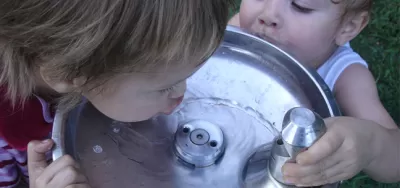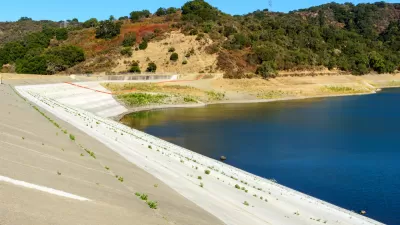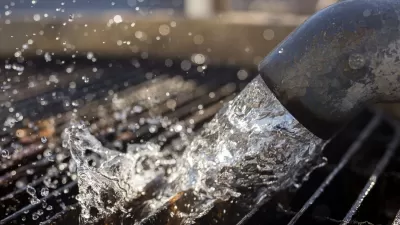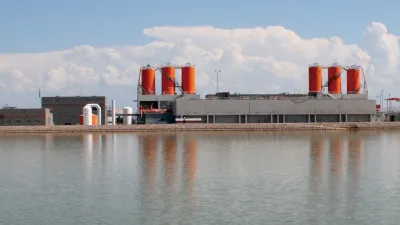Several cities in West Texas have a long history in wastewater reclamation, even using the water for drinking, due to the Texas drought. El Paso aims to build the nation's largest advanced purification project for direct water reuse.

Quartz's Brooklyn-based environment reporter, Zoë Schlanger, traveled to El Paso last month to take a deep dive into water treatment. "The technology already exists to treat human wastewater to drinking water standards; water engineers call it by the polite (if euphemistic) name of 'direct potable reuse [pdf],'” writes Schlanger.
But few city water utilities have been daring enough to try it on their customers, given its poor public image.
Indeed, "[t]he toilet-to-tap stigma is a big obstacle," reported Audrey Dilling for KALW, a San Francisco-based NPR affiliate, in October 2014, during what was then a three-year drought in the Golden State. Dilling was on a tour of the Silicon Valley Advanced Water Purification Center [listen to audio version]. While the treated wastewater is processed to drinkable standards, because it's "not regulated by the Health Department,” stated the guide, “It hasn't been cleared to drink." [See related post on the treatment facility where local politicians do indeed drink the water].
Right now there’s only one city in America where people drink recycled water directly from a plant like this -- Wichita Falls, Texas.
Laura Martin reported for Water Online in September 2014 that the first direct potable reuse, or DPR, project was by the Colorado River Municipal Water District in Big Spring, Texas.
After almost a year in operation, and after the rains filled the region's lakes, the Wichita Falls operation ended, reported Sara Jerome for Water Online in July 2015. The treated wastewater from the Cypress Water Treatment Facility then went from direct potable reuse, or DPR, to indirect potable reuse.
IPR can take on many forms. The water from the aforementioned Silicon Valley plant is sold for irrigation purposes and outdoor fountains. In Wichita Falls, the water is now sent to a lake where it is treated again before it can become drinkable.
El Paso's cutting-edge project
El Paso plans to take up where Wichita Falls left off, reported Marty Schladen in August 2015 for the El Paso Times, in that the goal is to use the water directly.
Anticipated to be open in 2020 at a cost of between $110 million and $150 million, the plant would add a crucial 10 million gallons per day — a little more than 9 percent of the utility's total demand on an annual basis.
It would seem the timeline for the Advanced Water Purification Facility project has been delayed based on Schlanger's most recent reporting.
Now the city is seeking grant funding to shepherd a potable-reuse plant through the remainder of a design process; water-utility officials think they can break ground on the plant “in the next few years,” according to Joshua Moniz, a public affairs coordinator for the El Paso water utility. Within a decade, El Paso hopes its residents will be drinking reclaimed sewage water.
In short, El Paso, situated in the middle of the punishingly dry Chihuahuan desert is on situated in the middle of the punishingly dry Chihuahuan desert is on the cutting edge of water technology. It really has no choice.
"Upon completion, the El Paso Advanced Water Purification Facility will be only the second true DPR plant worldwide," according to Arcadis, the design and consultancy firm which "conducted a nine-month pilot test of this concept to obtain Texas Commission on Environmental Quality approval (and will) establish design criteria for the full-scale facility."
El Paso Water already made drinking water history in 2007 when it "opened the Kay Bailey Hutchison Desalination Plant, named after its biggest congressional supporter," adds Schlanger. "It’s still the largest inland desal plant in the world, able to turn 27.5 million gallons of salty groundwater into drinking water every day."
FULL STORY: A major US city will start drinking its own sewage. Others need to follow.

Planetizen Federal Action Tracker
A weekly monitor of how Trump’s orders and actions are impacting planners and planning in America.

Maui's Vacation Rental Debate Turns Ugly
Verbal attacks, misinformation campaigns and fistfights plague a high-stakes debate to convert thousands of vacation rentals into long-term housing.

San Francisco Suspends Traffic Calming Amidst Record Deaths
Citing “a challenging fiscal landscape,” the city will cease the program on the heels of 42 traffic deaths, including 24 pedestrians.

Amtrak Rolls Out New Orleans to Alabama “Mardi Gras” Train
The new service will operate morning and evening departures between Mobile and New Orleans.

The Subversive Car-Free Guide to Trump's Great American Road Trip
Car-free ways to access Chicagoland’s best tourist attractions.

San Antonio and Austin are Fusing Into one Massive Megaregion
The region spanning the two central Texas cities is growing fast, posing challenges for local infrastructure and water supplies.
Urban Design for Planners 1: Software Tools
This six-course series explores essential urban design concepts using open source software and equips planners with the tools they need to participate fully in the urban design process.
Planning for Universal Design
Learn the tools for implementing Universal Design in planning regulations.
Heyer Gruel & Associates PA
JM Goldson LLC
Custer County Colorado
City of Camden Redevelopment Agency
City of Astoria
Transportation Research & Education Center (TREC) at Portland State University
Jefferson Parish Government
Camden Redevelopment Agency
City of Claremont





























